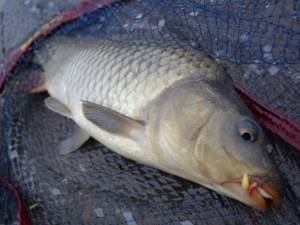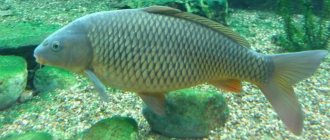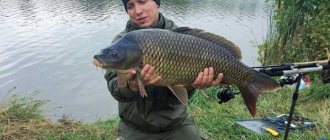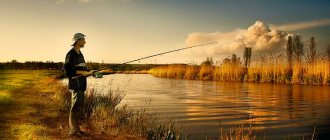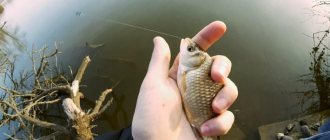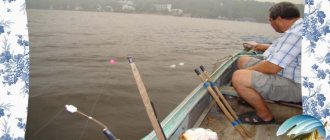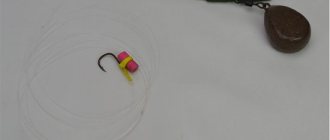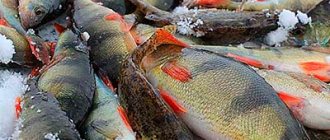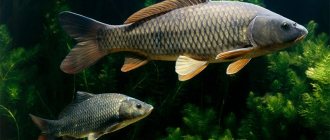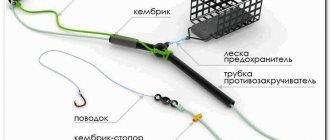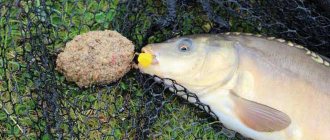Nikolay Linnik | May 2, 2021
Faith is the basis of any trophy fishing. It is extremely difficult to form and very easy to destroy. But faith helps us make bold decisions and emerge victorious from difficult situations that abound in such fishing. When you make the right decision and discover something that was previously unknown to you, you not only satisfy your motivation to catch a trophy fish, but also build self-confidence...
When I was younger, I often took multiple gear with me on fishing trips. When going fishing with a float rod, in addition, I dragged a feeder or even a spinning rod to the river bank. The main reason I did this was the hope that if the fish didn't bite the float rod, I could always try my luck with other gear. So I stroked my vanity. But more often than not, these additional gear only prevented me from concentrating on fishing...
Years have passed. I made certain conclusions for myself. And today I am completely confident that it is not the amount of gear that determines the success of fishing, but the correct presentation of the bait - in the right place and at the right time.
Many of my trips for trophy fish involve a lot of risk. Most often, ¾ of the time allotted for fishing is spent searching for promising spots and waiting for the trophy to come out to feed. After all, large fish always eat in portions. And you need to learn to calculate this golden time. When a fishing session lasts no more than one daylight hours, you can count on only one or two bites.
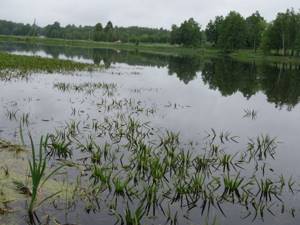
If I am completely confident in my gear, in the way it presents the bait to the fish, then fishing becomes much easier. All I can do is concentrate completely on choosing the time and place of fishing. Agree, this is a more professional approach to fishing than the one that was written about at the very beginning of this article. Give examples? Here is the most recent one.
How it all started
Several years ago I became interested in catching wild carp. This whole thing came to a head when, on one of the lakes I knew from childhood, fishermen managed to catch several good (2-4 kg) carp. The lake is not really a lake, but an abandoned reservoir. At the end of the 70s of the last century, a wave of enthusiasm for land reclamation swept across the country - in some places they drained, in others they irrigated.
There was no point in doing either of these things in this area, but in order to at least somehow report, they took it and built a simple dam on a small river, 15 meters wide. After the construction of the dam, the river overflowed to 100 - 150 m, but the maximum depth with such a width was only 2.5 - 3 m - and even then along the bed itself. And in the rest of the water area of the dammed river it is even less - 1.5 - 1.7 m.
There were no decent fish in this river, but after the reservoir was filled, the collective farm management stocked it with crucian carp and crucian carp. They settled it, but they didn’t think about how to catch fish. Due to poorly cut trees, it was impossible to stretch the seine across the reservoir. And after a few years, the grass began to grow quickly. This is how the new inhabitants of this reservoir found themselves abandoned to the mercy of fate. And gradually they were forgotten.
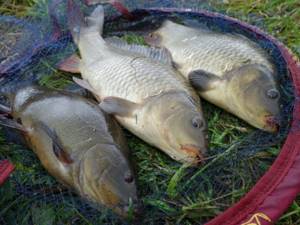
True, roach, perch, crucian carp and tench were caught, but carp were not. It was believed that the carp population had gradually become extinct or that electric poachers had a hand in this. But one of the fishermen caught a carp while fishing for tench. While fishing, he deliciously tore the fisherman’s fishing line and swam away safely. However, this fact became one of the most discussed news in the local fishing community for several days.
Inspired by the desire to catch wild carp, I began to prepare for the upcoming fishing trip. But I had almost no experience in catching this fish. After some thought, I decided to start with a method flat feeder.
Lure
The general rule for composing bait for carp fishing is: it should contain a large number of large components. These can be steamed grains of cereals, corn or peas, pieces of coarsely ground cake, rolled oats, particles of fish feed, canned corn, etc. The base of the bait should be sticky enough so that the bait balls can be easily cast over a long distance, but at the same time they should disintegrate quickly in the water.
the more of it, the better the bite, and it is almost impossible to overfeed the carp. More often, a scheme is used in which 60-80% of the bait is thrown to the fishing point immediately, and the rest is used for additional feeding. Sometimes maggots, chopped worms or bloodworms are added to this residue to increase the attractive effect.
But, if there is no other fish in the reservoir, except for carp, or there is very little of it, it is advisable to include these components in all the bait. The issue with the bait is even more unclear: carp can bite on almost anything, and its tastes often change within a short time, which is why if you take with you one bait, even one that has been tested and proven on a given reservoir, you can get into trouble. The best baits are: maggots, worms, and in the absence of small things - bloodworms, canned corn, mash, bread crust, pasta, rolled oats flakes.
Feeding is the key to successful fishing. In terms of efficiency, homemade baits are often not only not inferior, but even superior to store-bought ones. It is worth noting that bait for carp is extremely similar to bait for crucian carp. Some brands even produce bait for two types of fish at once.
Recipe No. 1
- 200-300 grams of crackers from black, not moldy bread, carefully crushed;
- Add 250-300 grams of milk powder and soy flour, 200 grams of egg powder to the resulting mass;
- Mix thoroughly until the mixture becomes a homogeneous granular mixture, adding 1 teaspoon each of fine salt and sugar;
- Mix with dry red clay;
- Before fishing, the bait is moistened to a thick viscous state;
Recipe No. 2
- Millet, pearl barley and semolina are placed in a large container and filled with water;
- Cook over low heat until each ingredient is completely cooked.
- Add a little unrefined vegetable oil, 2-3 tablespoons of honey, breadcrumbs, makukha (cake) to the resulting porridge.
- Let the bait sit and thicken
Among the baits, carp prefers:
- Undercooked new potatoes;
- Canned or boiled corn;
- Boiled peas;
- Millet;
- Bread crumb;
- Pea mastyrka;
- Steamed grains of rye or wheat;
- Semolina chatter;
- Boyles
In addition to baits, especially in spring and closer to autumn, carp also take the following baits:
- Maggot;
- Dung and earthworm;
- Bark beetle;
- Shitik;
Choosing a fishing spot
Spring
Carp is a heat-loving fish.
In the spring, its active fishing begins only when the water temperature in its habitat reaches 14C. This usually happens by the end of April-beginning of May, but in a cold spring, fish begin to be caught normally only towards the end of the last spring month. Selecting a location
In the spring, as the water warms up, carp begin to emerge from their winter shelters, occupying areas of reservoirs with a depth of up to 2 meters. The most promising at this time will be the upper edges of the holes, the shallows near the thickets of last year's reeds.
Tackle
Since carp stand near the shore at shallow depths in the spring, the most suitable gear would be a light fly rod up to 5 meters long. The equipment should be thin enough, but at the same time durable:
- The float is light and sensitive with a load of up to 1 gram;
- Line section 0.18-0.2 mm;
- Leash 0.14-0.16 mm;
- Hook No. 8-10.
Baits and lures
Among carp baits in spring, more nutritious baits are used:
- Muckworm;
- Bloodworm;
- Maggot;
- Dragonfly larva.
Fishing tactics
When fishing in spring, it is worth considering that carp are not yet as active as in summer. The fish are most active from lunch until 4-5 pm - at this time the water is warmest.
In order to catch it, you need to choose the most suitable place, moderately, so as not to overfeed the fish, feed it with a mixture that includes the bait used in fishing - chopped worms, small food bloodworms. In order not to scare away the sensitive carp, you should not often re-throw the tackle, often come close to the water, or make extraneous noise. In spring, the key to successful carp fishing is patience and silence.
Watch a video on carp fishing for free:
Selecting a location
In summer, carp spend most of the day at a deep depth of 3-5 meters or more near tall reed thickets casting a shadow, in places where underwater springs flow, near a flooded snag. In the morning and evening, when the water has not yet warmed up or has begun to cool down after the heat of the day, the carp rises to shallow waters overgrown with grass, rich in food, where it feeds throughout the night. Carp takes it well on cloudy days with rapidly passing rains.
Tackle
In summer, the entire arsenal of carp gear is used:
- float rod - light fly rods are used on lakes and ponds; for fishing in large bodies of water, match and Bolognese rods are more convenient;
- bottom gear – feeders and pickers, classic bottom fishing rods;
The equipment on the float rod, bottom rods and feeder is coarser and stronger than in the spring - the cross-section of the fishing line reaches 0.25-0.27 mm for the float rod, 0.3 mm or more for the feeder and bottom. The size of the hooks, depending on the nozzle, ranges from No. 10 -12 to No. 8-6.
We invite you to read: Silver carp killer tackle: how to make it yourself?
Baits and lures
In summer, carp gradually switches to a vegetarian menu, preferring:
- canned corn kernels;
- steamed peas;
- undercooked new potatoes;
- pea mastyrka;
- mash of semolina and water;
Among the baits, carp takes a worm, maggot
Fishing tactics
In summer, although carp are more active than in spring, they still have plenty of food and must be forced to bite. Therefore, when summer carp fishing, supplementary feeding is a prerequisite - mixtures can be either purchased or prepared independently. The main thing is that the bait that gets into the water creates turbidity and attracts fish with its smell and variety of ingredients - corn, peas, breadcrumbs, etc. Just like in the spring, carp do not like unnecessary noise.
Selecting a location
With the onset of autumn cold weather and a gradual decrease in water temperature, carp begin to move to the deepest places in reservoirs. And if at the beginning of autumn the carp still visits its summer feeding grounds, then closer to winter it slides into pits and pools. As in spring, carp in autumn bite more often during the day, when the water warms up as much as possible.
Tackle
In early September, when the water has not yet cooled down much, a float rod is still used to catch carp. In October and November, a feeder is a more catchy tackle, thanks to which you can catch carp from holes located far from the shore.
Baits and lures
The most preferable baits for carp fattening up for the winter at this time are dung worms, bloodworms, and maggots. He takes plant baits much less often than in summer and then as part of “sandwiches” with bait.
Fishing tactics
Autumn carp fishing requires not only knowledge of the deep places of the reservoir where large carp can stand, but also proper feeding and use of bait. Feed in small quantities, adding chopped worms or small bloodworms to the mixture; flavorings are added in slightly smaller quantities than in summer - cold water does not conduct odors well and its high concentration near the fishing site can scare away the fish. Baits should be chosen small in size - if it is not possible to place a medium worm on the hook, it is better to use a bunch of bloodworms secured with a silicone rubber band, 3-5 maggots pierced across the body.
Selecting a location
Fishing for carp in winter is not a common occurrence - as a rule, when the water temperature drops greatly, carp falls into torpor and remains there until spring. But there are also exceptions to the rules. Thus, carp have recently begun to be caught quite successfully in flowing and deep ponds, on rivers and reservoirs. For fishing, they choose deep wintering holes with a slow current, coastal snags with underwater springs gushing in them, pools at the mouths of rivers or streams flowing into large bodies of water.
Tackle
Carp are caught in winter using jigs and winter float gear. When choosing a fishing line, take into account the significant weight of the fish and its weak, but still weak, resistance - a fishing line with a cross-section of up to 0.22 mm is more suitable.
Large jigs with a diameter of 5 mm or more with strong hooks No. 8-12 are used.
Larger hooks are also placed on the float tackle.
Baits and lures
Among the baits, carp is most often caught on a bunch of bloodworms.
Fishing tactics
Winter carp fishing requires increased patience and attention from the angler. At this time, the fish feed much less and less often than in the summer, so having identified the treasured place, you need to feed it and abandon the gear to wait - the bite begins suddenly and ends the same way. Feed in small portions so as not to overfeed the fish.
Carp bite in winter on the first and last ice. The best carp bite is observed during thaws that last for several days. Its peak occurs in the afternoon and lasts from several tens of minutes to 2 hours.
The bite in the dead of winter weakens, or even stops completely. It is not possible to catch carp in January-February even on a paid site.
Day one, methodical
Catching pond fish with flat feeders is becoming more and more popular here every year. But it’s one thing to catch carp in a paid reservoir, where there are really a lot of them, and it’s completely different to try to catch its wild relative with this gear. When preparing for fishing, I did not take this point into account - and soon regretted it. Previously, I have repeatedly caught crucian carp, tench and even bluegills with flat feeders. So I had some skills in handling this gear. However, local carp turned out to be much more picky.
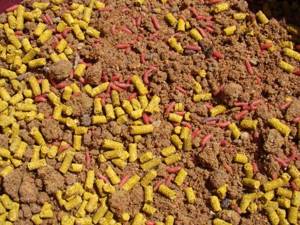
At first I thought I went a little overboard with the treats for them. The wonderful method mixture from Sensas radiated an exciting strawberry aroma throughout the entire lake - the neighbors on the shore even made jokes about it. The bait molded perfectly into the mold - and, it would seem, the carp simply had to try it. Moreover, I offered him a whole assortment of “sweets” as bait.
But three hours passed, and I could not record a single bite. And if the neighbor on the left had not pulled out two kilogram carp on a simple river feeder during this time, one might well have thought that the fish were simply in a bad mood today.
I’m trying to turn the situation in my favor and start feeding the point with a slingshot. The bait is the same, only with the addition of pellets and canned corn. But all this turned out to be in vain. Another three hours were wasted. Sometimes roaches would bite on clean corn, but this was not at all the fish for which I came here.
Analyzing the results of this fishing at home, I came to the conclusion that there are several reasons why the carp completely ignored my baits this time. This is a beautiful, aromatic French bait, which turned out to be completely unfamiliar food for the local carp - and they were apparently afraid to eat it. After all, a neighbor who was fishing fifteen meters to the left of me caught his carp using simple feed. But there was another reason - incorrectly chosen gear.

Reflecting on the past fishing, I suddenly caught myself thinking that I was uncomfortable fishing with a method feeder simply because I was not entirely sure of the correctness of my choice.
Day two: long live a mindful approach to fishing
A few days later I found myself on this lake again. Only now I took a match fishing rod with me. There were several arguments in favor of choosing this gear. Firstly, fishing here had to be done in shallow water - and at a distance of 25 m from the shore, the depth of the reservoir was no more than one and a half meters. And the feeder seemed to me too rough tackle. And secondly, I trusted the match fishing rod more. For many years I have successfully caught tench with this gear in shallow lakes heavily overgrown with grass - and the “match” has never let me down.
I also slightly changed the tactics for starting feeding of the fishing sector. In order, as they say, not to put all my eggs in one basket, after preliminary measuring the bottom, I feed two points at once. To a distant point, located not far from the dump into the river bed, using a slingshot, I threw about two dozen tightly molded balls of bait with the addition of a large proportion of chopped worms, corn and boiled maggots. For the closest point, I prepared the same amount of vegetable bait, but made it more loose. And to avoid annoying little things, instead of the animal component, I added 200 ml of 8 mm pellets with the smell of fishmeal and a jar of canned corn to the base mixture.
The distant point began to respond first. In the second hour of fishing, two kilogram “tuzik” and two tench of the same size were already swimming in the cage. The closest point is silent. At intervals of 20 minutes, I put a fresh portion of food into the water and carefully monitor the reaction of the fish. From time to time someone is carefully interested in bait. This is noticeable by the chain of gas bubbles that every now and then appears in the immediate vicinity of the float.
But the fish doesn’t dare try the bait yet. And then, closer to noon, a wonderful bite occurs at the nearest point. Oh, and this carp gave me a hard time! This is where the safety margin of match gear comes in handy. The fish walked around the lake for about 10 minutes, and I only managed to get it into the landing net on the fourth try. The scaly bronze beauty weighing four kilos was a pleasant bonus for my persistence in unraveling the mysteries of this abandoned reservoir.
It’s clear that the first experience of catching wild carp with match gear really stuck with me. And I began to accumulate statistics. Forgetting that bream and silver bream were actively pecking on the river, every morning I traveled 45 km only to experience the incomparable sensation of fighting with armored wild beauties. And I began to succeed in some things.
Relief and depth
Since carp fishing is mainly carried out on ponds with a very uniform bottom, any significant change in the relief should interest the angler. For a detailed study of the bottom, you can use a small depth gauge weighing 2-3 g, attached to a hook. Having cast to the maximum distance, reel in the line two or three turns of the reel handle, allowing the float to completely submerge in the intervals between reelings. If the depth differs from the set one, it is adjusted. After making two or three cycles of such casts (to increase accuracy), the approximate location of the depth difference (edge) is marked on the line with a marker. You can also make a couple of casts to the right and left at 15-20° from a straight line. This technique not only determines the bottom topography, but also examines it for the presence of algae, snags, etc. Skills in studying the bottom topography come very quickly and subsequently provide an invaluable service when fishing. It seems to me that in summer the fish prefer to stay in the upper part of the edge, sliding to the lower edge only under unfavorable conditions. However, it also happens, especially in artificial reservoirs of fish farms or very old ponds, that not only the edge, but in general there is no significant change in the bottom topography. In this case, we are free to choose the distance from which fishing will be done, and if there are no prerequisites to sharply increase the distance (for example, it is too shallow near the shore or the fish is clearly standing far away), then it is usually 20-30 m from the shore. The optimal depth for carp fishing is 2-3 m, but, of course, taking into account the total depth of the reservoir and the set of fishing conditions, it can change significantly. After exploring the reservoir (and in a familiar one, it’s better before measuring the depth), it’s worth starting to feed.
Tackle
Having gone through several options for arranging gear, I came to the conclusion that for catching carp with a match rod, the best option would be a powerful but flexible rod that can easily cope with landing this large and strong fish. From my existing arsenal of fishing rods, I chose the Browning Commercial King2 Pellet Waggler 3.3 m , and test up to 20 g. I must say that with this rod I experienced real pleasure from such exotic fishing.
The reel I used for these fishing trips was a Browning Xitan Master Match FD 940 . Distinctive features of this model are an exceptionally soft brake, a reliable clip, which, thanks to the presence of an additional gasket, does not injure the fishing line at all, and an aluminum spool of increased diameter. In addition to the fact that this reel allows you to reel out 105 cm of line in one turn of the handle, it is much more comfortable to fish for large fish with a wide spool.
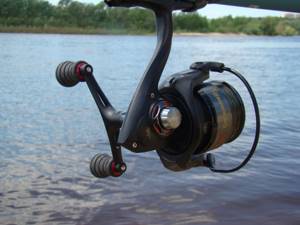
It turned out that when fishing for carp, the cross-section of the main fishing line should be at least 0.2 mm, and better if 0.22 - 0.28 mm. Such a significant thickness of the fishing line is necessary both for effective catching of fish and for combating floating grass, which every now and then appears in the fishing sector. In addition, the additional rigidity of a thick fishing line ensures that the float does not twist around the main load when casting.
It’s good if the main line slowly sinks in the water. This greatly reduces the effect of wind currents on the equipment. After going through several options, I chose two fishing lines - Colmic Steel Resistance and Balzer Feeder Master .
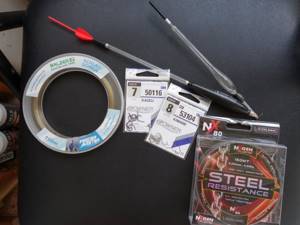
Match fishing rod for carp fishing
Rod selection
According to the advice of professional fishermen, the optimal length of a match rod is 3.9...4.5 m. And not only for catching carp, but also other types of fish.
Match rods, like spinning rods, are produced in different constructions and tests. The first characteristic is chosen according to your preferences, although most experts recommend purchasing slow action forms when “going for carp”. It is these fishing rods that, when loaded, bend from the butt itself, that allow you to fight fish most effectively and get more adrenaline.
There is no point in chasing a big rod test. 0...20 g or 5...20 g is quite enough. Moreover, the first option is preferable, since it allows, with a slow action, to fully experience the beauty of match fishing.
Choosing either a plug or telescopic match rod is a personal question. The former are less scratched at the joints; the second ones are faster to assemble/disassemble and allow you to leave all the equipment on the form.
Coil selection
Reels specifically for match fishing are available on the market in large quantities. They are distinguished by shallow-depth spools on which a smaller volume of fishing line is wound. This is explained by the fact that the latter are usually used 0.10...0.14 mm in diameter.
This type of reel is always marked with the inscription “Match”. The products also feature an increased gear ratio, which is usually equal to or greater than 1:5.
It is not necessary to buy your first reel for match gear from rods designed specifically for such rods. You can look for a regular spinning reel that comes with an extra spool just for the match. Or you can buy a separate match spool on the market for your own spinning reel.
Floats for shallow fishing
As already written above, by the time I became interested in carp fishing with a match fishing rod, I already had experience in catching tench in shallow lakes overgrown with grass. In order to present the bait to the fish as realistically as possible, I decided to abandon massive floats and limited myself to two models - the 6-gram Expert , which I used at long distances, and the 4.5-gram transparent Drennan Puddle Chucker , which I used effectively at short distances. Even when fishing shallow, I like to use self-loading floats.
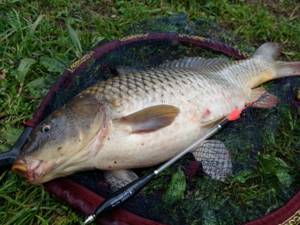
The presence of a load allows the float to take the desired position relative to the main line when casting - and thereby avoid many tangles of the equipment. To mount the float to the main line, I use a silicone adapter with a swivel. This is very convenient - especially if you need to quickly replace the float while fishing.
Float
It is necessary to select a float based on its carrying capacity, taking into account a number of factors: firstly, it must provide the necessary casting range and accuracy, secondly, the loading mass must be sufficient to fix the tackle at the fishing point and, thirdly, these two conditions must be ensured taking into account possible subsequent changes in fishing conditions (as a rule, the wind increases during the day, currents, waves, etc. appear). If you do not take these factors into account, you will have to redo the tackle from time to time, otherwise the number of bites will be significantly reduced. You can also use floats with variable loading, where part of the load is removed from the float, or add an appropriate amount of weights to the fishing line, thus changing the balance of the tackle.
Loading the float
I carry out the process of loading the float at the beginning of each fishing trip. First, I put a bead on the main line, then I mount a float using a silicone adapter. Then, raising the float up about a meter, I form the main load. I use no more than four pellets for this, because... a larger number of them can provoke frequent tangles of the fishing line.
By the way, I know fishermen who prefer to use “olives” instead of pellets as the main load in sliding rigs. But for me pellets are preferable. Several times I have seen olives get tangled when casting a rig, so for me, shotguns are the best choice.
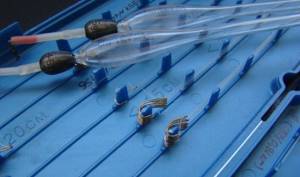
Next, a small carabiner is tied to the end of the main fishing line, to which the leash will subsequently be attached. Most often I use several No. 6 pellets as a backup. And only after that I tie a stop knot on the main line.
Match tackle for carp
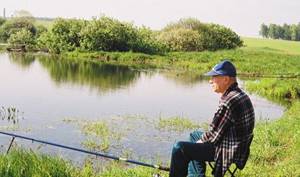
In the Moscow region there are many pay ponds where carp are often caught when fishing for crucian carp with a fly rod with a blind rig. This method is distinguished by its mobility, the ability to use attachments that are weakly held on the hook, and most importantly, when casting there are extremely rarely overlaps between the leash and the main fishing line. But it also has disadvantages: the fishing range from the shore is limited, as a rule, to a distance of 10-15 m, the use of thin fishing lines is excluded, the fishing process takes place above the baited area. Match tackle for carp fishing does not have all these shortcomings.
For the first time, the cultivation of this fish began in China. Then breeders from many countries created various breeds of carp: naked, mirror, scaly. Carp, as a rule, differs from carp, its wild counterpart, by its greater body height and humpback. Thanks to their omnivorous nature, carp grow quickly, reaching a weight of 400-600 g in two years of life. In general, carp grow up to a meter in length with a considerable weight - there are cases of catching carp weighing 20-30 kg. It feeds on various aquatic organisms and larvae, which it finds in silt, among algae and snags, as well as all kinds of plant foods. Adult carp sometimes eat small fish. In winter, carp are inactive, but in some reservoirs (with a hard bottom) they are sometimes caught from the ice.
SEARCHING FOR CARP SITES In small ponds, carp sites can be found in places where the bottom goes steeply into the depths, among gaps of aquatic vegetation. In lakes and reservoirs, it also stays on the border of deep-water areas, near underwater elevations overgrown with grass, going out to feed in shallower areas. River carp stick to quiet, deep holes, and at dawn they like to visit bays and creeks to dig in the bottom silt in search of tasty larvae and shells. This can be easily determined by the chains of bubbles coming from the bottom.
Large carp especially love to visit colonies of the zebra mussel. Dreissena is not only a high-calorie food for carp. It is precisely where its colonies are located that there is always enough oxygen and there is excellent water circulation. A rough bottom with varied topography also attracts carp. It is no coincidence that in the West, some owners of private carp ponds create many artificial snags, which over time become favorite habitats for large carp. In spring, carp begin to be active after the water warms up to about +10. As the water gets colder, the spring carp bite worsens sharply. In general, it must be said that he feels most comfortable at a water temperature in the range from +7 to +18. At the beginning of summer, during the daylight hours, several periods can be distinguished during which carp are most active in search of food. This is the early morning hours - just after sunrise. Noon and time after sunset - before dark. The rest of the day, the carp either stands at half-water or walks in its upper layers, throwing itself upright above the surface and noisily falling back into the water. Towards the end of summer, on warm cloudy days with little wind, the bite sometimes continues from dawn to dusk. Large individuals are also found at night.
In the middle zone, carp fishing in ponds in open water begins in May, when the water warms up well enough, and ends in September-October, when it gets colder. In flowing waters, carp remain active longer.
IF YOU FAIL TO FEED, YOU WILL NOT Catch Experience shows that you can successfully fish for carp only, as a rule, in well-fed places. And during the fishing process, the bite is activated if you throw in portions of bait from time to time: boilies, granulated feed based on cakes, steamed cake, peas, boiled crumpled potatoes (new), bran mixed with ground toasted sunflower seeds. You can, of course, also use fresh feed mixtures intended for carp. Anise oil (very dosed), vanillin, crushed hemp seed, and special carp attractants are used as aromatic additives. Carp has an excellent sense of smell, and if you guessed right with the bouquet of aromas, it will certainly be suitable for bait.
CHOOSING A RODS A well-chosen match rod with a certain margin of safety is the first step on the path to mastery. Optimal: length 3.96 m, form has 12 rings plus a tulip. Build quickly. All match rods can be legitimately divided into some kind of classes based on the weight of the equipment being cast (float, set of sinkers, bait). Light class - up to 8-10 g, medium - up to 20-25 and heavy - over 25 g. Some models of match rods are designed to cast equipment up to 80 g. With such a rod, you can make casts at a distance of up to 100 m without any problems. The casting distance is influenced by the following factors: rod structure, uniform winding of fishing line on the reel spool, shape and weight of the float, wind direction (side, head, from the shore). When choosing a fishing rod, be sure to pay attention to the number and location of the rings on the blank. They must be of a suitable diameter (the first from the coil is at least 8 mm inside) and installed on high legs. Otherwise, you will constantly be dealing with wet line sticking to the blank, which naturally reduces your casting distance. When you cast forcefully over your head and the main line overlaps the tulip or ring of the rod, you can simply “shoot” the rig with the float dear to your heart. Therefore, before each cast, make sure that there is no overlap. I consider the most versatile rod to be up to 4 m long. With longer ones, problems arise when fishing from a bank overgrown with trees and bushes, which, you see, happens quite often.
A reel for match carp fishing should be selected after purchasing a fishing rod. First of all, both of these elements of gear must be well balanced. The less the rod and reel weigh, the better. The main difference between a match reel and a spinning reel is the slightly larger diameter of the spool and it is less deep. The fact is that when casting fairly light equipment (2-5 g), and even with a headwind or side wind, delivering the bait to the feeding point will be problematic. You can, of course, make the equipment heavier, but this does not always work with cautious carp - the fish becomes extremely picky. A matcher should be considered balanced if, after installing the reel, the center of gravity is located between the upper part of the handle and the first throughput ring.
A LOT DEPENDS ON THE REEL Quite often, novice carp fishermen have to deal with questions about how much weight the reel should be, how many bearings it should have, etc. When choosing a reel, a lot depends on what size carp you are going to fish for. Runts up to 500 g are one thing, and seasoned trophies, the fight against which is truly an exciting event, is quite another. There are several basic rules that must be followed when choosing a reel for carp fishing.
You purchased a reel with a front brake, forgetting that after hooking the carp makes a powerful throw. In this case, using the rear clutch will, of course, be much more convenient. Experienced carp anglers, by adjusting the clutch during the fishing process, can easily reel in even such strong fish as carp. 2. Often carp have to be caught at a distance of 50 meters or more from the shore. In such a situation, a high-speed reel will make your actions quicker. With its help, you will quickly reel in the equipment, which will have a positive effect on your fishing results. When fishing for large carp, it is not the number of bearings that is important, but in which units they are located. This is primarily the rotor, drive gear supports, and line roller.
SOMETHING ABOUT THE EQUIPMENT The main requirement for carp equipment is its reliability. It is necessary to make it a rule to carefully check the knots before each fishing trip. It is better to abandon swivels, carabiners and other attributes that not only scare away cautious carp, but also significantly weaken the strength of the tackle. In this case, the leash is attached to the main line using the “loop-to-loop” method. Don’t forget that the more knots there are, the less strength the gear has. In order not to waste time installing equipment on the shore of a reservoir, several equipment is made at home, completely ready for connection to the main fishing line. 2-3 plastic bags with equipment is not the biggest load when going fishing. But all that remains is to measure the depth and connect the equipment to the main fishing line.
Depending on the weight of the equipment, a high-quality fishing line with a diameter of 0.16-0.20 mm is used as the main one. A thicker line significantly reduces the casting distance, and it “sails” more strongly under the influence of current or wind. In any case, the leash should be weaker in strength than the main line. When fishing for carp weighing over five kilograms, you need appropriate gear. And finally about the floats. In match fishing, you can use both regular floats and self-loaded ones. In recent years, torpedo-shaped floats have been used when fishing for carp. Why? Firstly, they allow you to make long casts, and secondly, their load is easily adjusted using removable washers. But most importantly, do not be lazy at home, taking into account the nozzle, adjust the float surround so that 2 cm of the antenna is above the surface of the water.
Vladimir Kazantsev June 19, 2012 at 00:00
Durable leashes
No matter how elegant the match tackle may look, it will be completely wrong to go after carp with thin leashes. This fish is strong, and after hooking it immediately rushes to the side. No matter how high-quality the reel’s friction brake is, only a strong leash can withstand the first jerk of this fish. So when fishing for carp, I don’t use fishing line thinner than 0.18 mm for leashes.
The second, and very important point, is the length of the leash. After going through several options, I settled on very short (7 - 10 cm long) leashes. Carp is the absolute master of the reservoir, and it takes the bait without any special ceremony. So there is no need to worry that the fish will feel the weight of the sinkers early. But a short leash is less prone to tangling and twisting.
Rod selection
Tackle for catching this strong fish must be very durable. As a rule, manufacturers of match gear do not write the carrying capacity; on some models it is indicated that this form is for carp fishing. In any case, it is better to consult the seller.
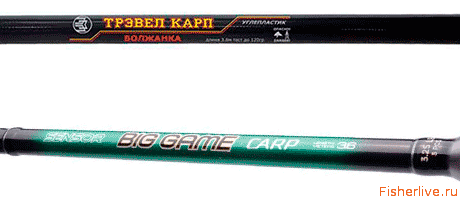
When choosing a fishing rod, you need to accurately imagine the fishing conditions. If bushes and trees grow along the banks of a reservoir, then the length of the fishing rod should be short so that it would be convenient for you to cast. At the same time, there is no need to choose very short blanks, since the fish usually stands far away, and casting light equipment with a short rod is quite problematic.
For this type of fishing, a medium action rod will be the most versatile. With such tackle you can cast the rig far, and at the same time, when fishing, a medium-action rod will perfectly dampen the jerks of the fish.
The test is selected depending on the weight of the equipment. When trophy fishing, the equipment is quite heavy, since you have to cast far, so the test should be up to 20 grams. You can also install light equipment on such rods; this will be important when you have found a promising place not far from the shore, because the closer the fish is to the shore, the more careful it is.
Hooks
To catch carp with a match fishing rod, I most successfully used two models of hooks: Owner Kiwami (53104) No. 8 and Owner Kaizu (50116) No. 7 . Both models are very durable. Kiwami when I used a “sandwich” of worm, maggot and corn as bait. But Kaizu worked better in cases where the fish reacted more actively to bulky baits in the form of a pea chop or several grains of canned corn.
I hope that this article will give you a slightly different perspective on the principles of carp fishing with a float rod. Try to move away from hackneyed stereotypes - and I’m sure you’ll like it.
Have fun fishing!
